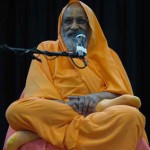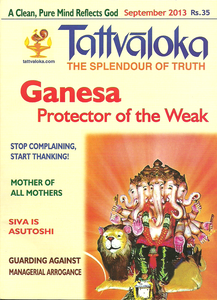
I have just been informed that Swami Dayananda has given permission to open a Twitter account for posting his sayings. For those who indulge in such things, the ‘Twitter handle’ is @swamijisays. I guess that they are likely to provide more worthwhile reading than most tweets…
Monthly Archives: October 2014
Q. 363 – Divine Grace
Q: Over the past eight years I have developed a personal relationship with a God of my understanding – or should I say with a God of my non understanding and I know that the term God is loaded and perhaps not word enough. I love God and naturally want to be with God.
I have some experience of Hinduism and spent time studying Buddhism, I even spent time living at a Buddhist center while going about my ordinary business of work, life and family. I couldn’t continue with Buddhism even though they were wonderful people because in my heart I knew it was not the right path for me and I felt conflicted. I returned to my love of Hindu practices because it felt more right for me and over the past two years I have tried to find my way. I have deepened my understanding through reading books, internet teachings on you tube and meditation.
More recently I have ventured upon Advaita Vedanta and it feels right for me. However, I have no teacher and no one to ask when I have questions. Sometimes it all gets a bit too non dual for me and I feel disconnected from the love part with all the philosophy and intellectual explanations. I experienced the grace of God eight years ago when I was in a desperate plight and Divine Grace is an absolute for me. What I want to know is how does Grace happen, is it Brahman or Divine consciousnesses. Thank you for any time and consideration you might give to answer my question. Continue reading
Vision Of Truth (sad darshanam) – Part 19
अज्ञस्य विज्ञस्य च विश्वमस्ति
पूर्वस्य दृश्यम् जगदेव सत्यम् ।
परस्य दृश्याश्रय भूतमेकम्
सत्यम् प्रपूर्णम् प्रविभात्यरूपम् ॥—२०
aj~nasya vij~nasya cha vishvamasti
pUrvasya dRishyam jagadeva satyam
parasya dRishyAshraya bhUtamekam
satyam prapUrNam pravibhAtyarUpam—20
aj~nasya = for the ignorant, vij~nasya cha = for the wise also; vishvamasti = there is world; pUrvasya dRishyam jagadeva satyam = for the former the seen world is real;
parasya = of the other; dRishyAshraya bhUtamekam = that has become the substratum of the world; satyam = prapUrNam = whole; pravibhAtyarUpam = formless shines
The world exists for the ignorant and the wise man. To the former the seen world alone is real; while to the other that has become the substratum of the seen, the whole, formless truth shines.
The manifested universe ‘becoming’ from the unmanifest?
“At the beginning of all things, there was neither being nor non-being, and what existed was an impenetrable darkness” – R.V. X 129.
“From the unmanifested (asat) the world of names and forms (sat) is said to arise.” – Taittiriya Up ll.7.1 (S. Radhakrishnan trans.)
(The manifested universe – the world of names and forms – is called sat, and its unmanifested condition asat. The possible or potential is prior to the actual… Asat, non-existent, does not mean absolute non-being. It is a state in which name and form were not manifested: avyakrta-nama-rupam – S. Radh.)
In the Chandogya Up there is this: “in the beginning this was non-being. That was being; it came into existence… “ – CU, lll.19, The Upanishads, trans. & ed. Valerie J. Roebuck (2003). (In Radhakrisnanan trans.: “In the beginning this (world) was non-existent. It became existent. It grew… “)
As Valerie J. Roebuck notes, this is in apparent disagreement with the following:
“In the beginning, good lad, this was being*, one alone without a second. Some say, ‘In the beginning this was not-being, one alone without a second. From that not-being, being was produced’. But, good lad, how could that be?, he said. How could being be produced from non-being? In the beginning, good lad, surely this was being, one alone without a second.
‘It thought, ‘Let me become many; let me be born’” (CU Vl. 2. 1-2)
*Under Note 36, V. J. Roebuck writes: “That was being: Or perhaps, ‘it became being, though the verb used is asit, not abhavat’.
Note. Any thoughts on the above, or is it clearly only an apparent contradiction? Secondly, what does ‘becoming’ mean in an ambience of non-duality, e.g. the unmanifest ‘becoming’ manifested?
The End of Becoming
Here is an essay I wrote on this topic some time back.
http://www.advaita.org.uk/discourses/durga/becoming_durga.htm
What comes first, being or desire [becoming]?
“With being arising in consciousness, the ideas of what you are arise in your mind, as well as what you should be. This brings forth desire and action and the process of becoming begins. Becoming has, apparently, no beginning and no end, for it restarts every moment. With the cessation of imagination and desire, becoming ceases and the being this or that merges into pure being, which is not describable, only experienceable.
“The world appears to you so overwhelmingly real because you think of it all the time; cease thinking of it and it will dissolve into thin mist. You need not forget; when desire and fear end, bondage also ends. It is the emotional involvement, the pattern of likes and dislikes which we call character and temperament that create the bondage.”
– Nisargadatta Maharaj, I am That
“There is no becoming, no destruction, no one in bondage, no one having desire to be released, no one making effort (to attain liberation) and no one who has attained liberation. Know that this is the absolute truth”
– Bhagavan Ramana Maharshi, quoting Mandukya Karika
Traditional Path
- Once self-ignorance is admitted as the problem, then it follows necessarily that self-knowledge is required to remove it. In turn this implies the need for a teacher or material to impart that knowledge and consequently, effectively a path and a seeker etc. We do not have any sense organ for ‘self-knowledge’. All of the usual pramANa-s only provide information about the world of facts, observations and information (which includes our body and the subtle aspects of thoughts and emotions).
- The seeker might well ask why it is that a sampradAya teacher should be better or more worthy of listening to than the independent teacher. The answer is simple – authority (in the sense of proven to work) and training. Why should one pay more attention to the claims of one ‘ordinary person’ than another? If a totally unqualified teacher says ‘This is it’ and my own experience tells me that “no it isn’t”, who is right? Should I not give more credence to first-hand experience? On the other hand, if a teacher is able to say “this is what my teacher told me” and so on, back down a noble line of sages to the shruti itself, then that is worthy of attending to.It might be said that the traditional path is a well-worn one and we are therefore far less likely to stray, whereas the neo-advaitin path is, by its own admission, no path at all.
Enlightenment: The Path through the Jungle, Dennis Waite, O-Books. ISBN: 978-1-84694-118-4. Extract Link
Buy from Amazon US, Buy from Amazon UK
Becoming and Progressive Paths
Quote
“Dogmas, doctrines and progressive paths which promise eventual enlightenment, or Nirvana, or the Kingdom of Heaven, through sacrifice, discipline, refinement and purification of the self, appeal tremendously to that within the seeker which feels unworthy. Hence, the power of classic religion and teachings of becoming. Traditional Advaita is just another one of these.”
Tony Parsons
Full article can be read here: http://www.theopensecret.com/traditionalnottwo.html
Vedanta the Solution – Part 11
VEDĀNTA the solution to our fundamental problem by D. Venugopal
Part 11 discusses the qualifications required for commencing Self-inquiry.
There is a complete Contents List, to which links are added as each new part appears.
upadesha sAhasrI – Part 22
 Part 22 of the serialization of the presentation (compiled by R. B. Athreya from the lectures given by Swami Paramarthananda) of upadesha sAhasrI. This is the prakaraNa grantha which is agreed by most experts to have been written by Shankara himself and is an elaborate unfoldment of the essence of Advaita. Note that this is the concluding part of the series.
Part 22 of the serialization of the presentation (compiled by R. B. Athreya from the lectures given by Swami Paramarthananda) of upadesha sAhasrI. This is the prakaraNa grantha which is agreed by most experts to have been written by Shankara himself and is an elaborate unfoldment of the essence of Advaita. Note that this is the concluding part of the series.
Subscribers to Advaita Vision are also offered special rates on the journal and on books published by Tattvaloka. See the full introduction

